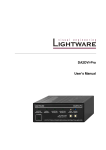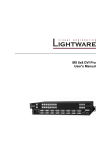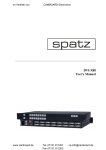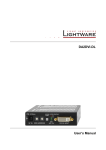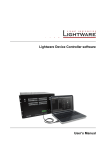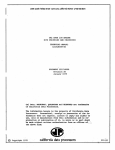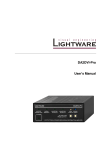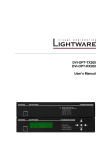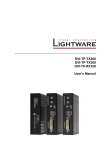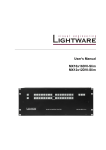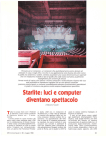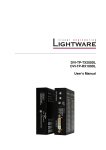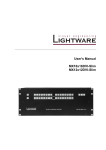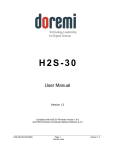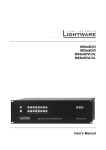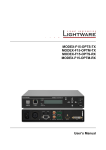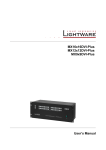Download MX32x32DVI-Pro MX16x16DVI-Pro User`s Manual
Transcript
MX32x32DVI-Pro
MX16x16DVI-Pro
User's Manual
.
Page 2 / 79
MX32x32DVI-Pro
User’s Manual
SAFETY INSTRUCTIONS
Class I apparatus construction. This equipment must be used with a main power system with
a protective earth connection. The third (earth) pin is a safety feature, do not bypass or
disable it.
This equipment should be operated only from the power source indicated on the product.
To disconnect the equipment safely from power, remove the power cord from the rear of the
equipment, or from the power source. The MAINS plug is used as the disconnect device, the
disconnect device shall remain readily operable.
There are no user-serviceable parts inside of the unit. Removal of the top cover will expose
dangerous voltages. To avoid personal injury, do not remove the top cover. Do not operate
the unit without the cover installed.
The apparatus shall not be exposed to dripping or splashing and that no objects filled with
liquids, such as vases, shall be placed on the apparatus.
The apparatus must be safely connected to multimedia systems. Follow instructions
described in this manual.
Replacing the AC fuse
Unplug the AC power cord from the equipment
Locate the AC fuse on the rear of the unit
Replace only the AC fuse as indicated on the rear panel of the unit: 3.15A fast
blowing
Connect the power cord to the switcher and to the AC power source. Make sure
the switcher is working properly.
WEEE
( W as t e E lec tr ica l & E lec tr on ic Equ ip me n t)
C o r rect D is po sa l o f T h is P ro du ct
This marking shown on the product or its literature, indicates that it should not be
disposed with other household wastes at the end of its working life. To prevent
possible harm to the enviroment or human health from uncontrolled waste disposal,
please separate this from other types of wastes and recycle it responsibily to promote
the sustainable reuse of material resources.
Household users should contact either the retailer where they purchased this product,
or their local government office, for details of where and how they can take this item
for environmentally safe recycling.
Business users should contact their supplier and check the terms and conditions of the purchase
contract. This product should not be mixed with other commercial wastes for disposal.
Page 3 / 79
DECLARATION OF CONFORMITY
We,
Lightware Kft. 1071 Budapest Peterdy str. 15 HUNGARY
as manufacturer declare, that the products
MX32x32DVI-Pro
MX16x16DVI-Pro
( Computer Matrix Switcher )
in accordance with the EMC Directive 2004/108/EC and the Low Voltage Directive
2006/95/EEC are in conformity with the following standards:
EMI/EMC .................... EN 55103-1 E3, EN 55103-2
Safety .......................................... EN 60065 Class I
Date:
01 September 2007
Name:
Gergely Vida ( Managing Director )
Signed:
Page 4 / 79
MX32x32DVI-Pro
User’s Manual
Table of contents
1
GENERAL DESCRIPTION............................................................................................................. 8
1.1
BOX CONTENTS ........................................................................................................................ 8
1.2
MODULAR ROUTER CONCEPT .................................................................................................... 9
1.2.1 Router frames .................................................................................................................... 9
1.2.2 Input Cards ........................................................................................................................ 9
1.2.3 Output Cards ..................................................................................................................... 9
1.3
FEATURES ............................................................................................................................. 10
1.4
FRONT AND REAR VIEW ........................................................................................................... 11
1.4.1 Front Panel view .............................................................................................................. 11
1.4.2 Rear view......................................................................................................................... 12
1.5
ELECTRICAL CONNECTIONS ..................................................................................................... 13
1.5.1 DVI inputs ........................................................................................................................ 13
1.5.2 DVI outputs ...................................................................................................................... 14
1.5.3 RS 232/422 control port................................................................................................... 15
1.6
ADVANCED EDID MANAGEMENT ............................................................................................. 16
2
OPERATION ................................................................................................................................ 17
2.1
POWER................................................................................................................................ 17
2.2
FRONT PANEL OPERATIONS............................................................................................ 17
2.2.1 TAKE / AUTOTAKE modes ............................................................................................. 17
2.2.2 CONTROL LOCK ............................................................................................................ 17
2.2.3 SWITCHING .................................................................................................................... 18
2.2.4 SAVE or LOAD PRESETS .............................................................................................. 19
2.2.5 VIEW current state........................................................................................................... 19
2.2.6 OUTPUT LOCK ............................................................................................................... 20
3
RS 232 / 422 CONTROL .............................................................................................................. 22
3.1
SWITCHING AND CONTROL COMMANDS .................................................................................... 23
3.1.1 Switch one input to one output ........................................................................................ 23
3.1.2 Switch one input to all outputs......................................................................................... 23
3.1.3 View connection on the specified output ......................................................................... 23
3.1.4 View connection on all outputs ........................................................................................ 23
3.1.5 View mutes on all outputs................................................................................................ 24
3.1.6 Mute specified output....................................................................................................... 25
3.1.7 Unmute specified output.................................................................................................. 25
3.1.8 Lock specified output ....................................................................................................... 25
3.1.9 Unlock specified output ................................................................................................... 25
3.1.10
Save preset to the specified memory location ............................................................ 26
3.1.11
Load preset from the specified location ...................................................................... 26
3.1.12
Reload factory default PLL setup ................................................................................ 26
3.2
ROUTER STATUS COMMANDS .................................................................................................. 27
3.2.1 View product type ............................................................................................................ 27
3.2.2 View serial number .......................................................................................................... 27
3.2.3 View Firmware version of the CPU.................................................................................. 27
3.2.4 View Router’s health........................................................................................................ 28
3.2.5 View Installed i/o cards’ hardware ................................................................................... 28
3.2.6 View installed controllers’ firmware ................................................................................. 29
3.2.7 View current control protocol ........................................................................................... 29
3.2.8 Set current control protocol ............................................................................................. 29
Page 5 / 79
3.3
EDID ROUTER COMMANDS ...................................................................................................... 30
3.3.1 Route EDID to the selected input (static)......................................................................... 30
3.3.2 Route EDID to the selected input (dynamic).................................................................... 30
3.3.3 Route one EDID to all inputs............................................................................................ 30
3.3.4 Save EDID from output to memory location (Learn EDID) .............................................. 30
3.3.5 View EDID validity table................................................................................................... 31
3.3.6 View EDID header ........................................................................................................... 31
3.3.7 Upload EDID content from the router .............................................................................. 32
3.3.8 Download EDID content to the router .............................................................................. 33
3.4
ROUTER INITIATED COMMANDS ................................................................................................ 34
3.4.1 EDID status changed ....................................................................................................... 34
3.4.2 Error responses ............................................................................................................... 35
3.5
COMMANDS – QUICK SUMMARY ............................................................................................... 36
4
ETHERNET SETUP...................................................................................................................... 37
5
SOFTWARE CONTROL –USING LIGHTWARE MATRIX CONTROLLER ................................ 40
5.1
INSTALLING MATRIX CONTROLLER ................................................................................ 40
5.2
USING LIGHTWARE MATRIX CONTROLLER ................................................................................ 42
5.3
MENU DESCRIPTION .............................................................................................................. 44
5.3.1 File menu ......................................................................................................................... 44
5.3.2 View menu ....................................................................................................................... 45
5.3.3 Comm Port menu............................................................................................................. 46
5.4
I/O SWITCHING ....................................................................................................................... 47
5.5
PRESET OPERATIONS ........................................................................................................... 48
5.5.1 SAVE PRESET ................................................................................................................ 48
5.5.2 LOAD PRESET ................................................................................................................ 48
5.5.3 RENAME a preset:........................................................................................................... 48
5.6
ERROR MESSAGES ............................................................................................................... 49
6
WEB CONTROL – USING LIGHTWARE WEB MANAGER ....................................................... 50
6.1
MENU DESCRIPTION ............................................................................................................... 51
6.2
CROSSPOINT OPERATIONS...................................................................................................... 52
6.2.1 I/O switching..................................................................................................................... 52
6.2.2 Mute outputs .................................................................................................................... 52
6.2.3 Lock outputs..................................................................................................................... 53
6.3
PRESET OPERATIONS .............................................................................................................. 53
6.3.1 Save Preset...................................................................................................................... 54
6.3.2 Load Preset...................................................................................................................... 54
6.4
EDID ROUTER OPERATION...................................................................................................... 54
6.4.1 Change emulated EDID at one or all inputs .................................................................... 55
6.4.2 Learn EDID from attached display device ....................................................................... 56
6.5
NETWORK CONFIGURATION ..................................................................................................... 57
6.5.1 Automatic IP Address Configuration................................................................................ 57
6.5.2 Static IP address configuration ........................................................................................ 58
6.5.3 Loading the default IP settings......................................................................................... 58
6.5.4 TCP Port Configuration.................................................................................................... 59
6.5.5 Loading the default TCP Port settings ............................................................................. 59
7
ADVANCED EDID MANAGEMENT: USING EDID ROUTER ..................................................... 60
7.1
WHY IS EDID MANAGEMENT NECESSARY? ............................................................................... 60
7.2
ABOUT ADVANCED EDID MANAGEMENT .................................................................................. 61
7.3
EDID ROUTER MENU DESCRIPTION .................................................................................... 62
7.3.1 EDID menu....................................................................................................................... 62
7.4
EDID ROUTER OPERATION...................................................................................................... 63
7.4.1 Change emulated EDID at one or all inputs .................................................................... 64
7.4.2 Learn EDID from attached display device ....................................................................... 65
7.4.3 Download EDID from file to memory ............................................................................... 66
7.4.4 Upload EDID from memory to file .................................................................................... 66
8
FIRMWARE UPGRADE ............................................................................................................... 67
Page 6 / 79
MX32x32DVI-Pro
User’s Manual
9
SPECIFICATIONS........................................................................................................................ 71
9.1
MECHANICAL DRAWINGS ........................................................................................................ 73
9.1.1 Mechanical Drawings – Front View ................................................................................. 73
9.1.2 Mechanical Drawings – Rear View.................................................................................. 74
9.1.3 Mechanical Drawings – Top View ................................................................................... 75
9.1.4 Mechanical Drawings – Left View.................................................................................... 76
9.1.5 Mechanical Drawings – Right View ................................................................................. 77
10
WARRANTY................................................................................................................................. 78
11
QUALITY CHECK RECORD........................................................................................................ 79
11.1
11.2
HARDWARE ............................................................................................................................ 79
ELECTRICAL CHECK ................................................................................................................ 79
Page 7 / 79
1
General description
1.1 Box contents
Page 8 / 79
−
Routing switcher
−
User's manual
−
IEC power cable
−
CD-ROM with control software
−
2mm allen key
−
RS 232 9 pole D-sub Male to Female cable
−
UTP cross link cable
MX32x32DVI-Pro
User’s Manual
1.2 Modular router concept
MX32x32DVI-PRO and MX16x16DVI-PRO is a modular matrix switcher family that
allows to build custom I/O sizes that meets the user’s requirements. Different type
of input and output cards gives the maximum flexibility for rental and installation
signal transmission.
1.2.1 Router frames
MX-DVI-FR16
16x16 router frame with optional built in control panel
MX-DVI-FR32
32x32 router frame with optional built in control panel.
Not compatible with MX-RJ45-DVI-IB; MX-RJ45-DVI-OB;
MX-OPT-DVI-IB; MX-OPT-DVI-OB.
MX-DVI-FR16R
16x16 router frame with dual redundant power supply
MX-DVI-FR32R
32x32 router frame with dual redundant power supply
1.2.2 Input Cards
MX-DVID-IB
8 channel DVI-D (digital only) single link input card
MX-DVII-IB
8 channel DVI-I (digital DVI and analog RGB) input card
containing 8 DVI-I connectors
MX-RJ45-DVI-IB
8 channel RJ-45 to DVI-D converter input card, used for
DVI over CAT5 signal transmission
MX-OPT-DVI-IB-NT
8 channel fiber optical input card with built in fiber to
DVI conversion – 4 duplex Neutrik Opticalcon connectors
MX-OPT-DVI-IB-LC
8 channel fiber optical input card with built in fiber to
DVI conversion – 4 LC duplex connectors
MX-HDMI-IB
8 channel HDMI input card
MX-DVIDL-IB
4 channel dual link DVI-D (digital only) input card
1.2.3 Output Cards
MX-DVID-OB
8 channel DVI-D (digital only) single link output card
MX-RJ45-DVI-OB
8 channel RJ-45 converter output card, used for DVI over
CAT5 signal transmission
MX-OPT-DVI-OB-NT
8 channel fiber optical output card with DVI signal
reclocking – 4 duplex Neutrik Opticalcon connectors
MX-OPT-DVI-OB-LC
8 channel fiber optical output card with DVI signal
reclocking – 4 LC duplex connectors
MX-HDMI-OB
8 channel HDMI output card
MX-DVIDL-OB
4 channel dual link DVI-D (digital only) output card
Page 9 / 79
1.3 Features
50 meter input cable compensation – Using 22AWG high quality DVI cable, the
inputs are automatically compensated for up to 50 meter cable
length, which extends installation possibilities even on highest
HDTV or computer resolutions. In case of lower pixel
resolutions, this length can be even higher.
Advanced EDID Management – The user can emulate any EDID on the switcher's
inputs independently, read out and store any attached monitor's EDID
in 100 internal memory locations, upload and download EDID files
using Matrix Control Software.
Non-blocking cross point matrix architecture – The router allows any input to
be switched to any output or more outputs simultaneously.
1.65 Gb/s channel transmission – Routes any DVI single link signal between 25
and 165 MHz pixel clock frequency conforming to DVI 1.0
standard or dual link depending on input card type.
Supports all HDTV resolutions – 720p, 1080i and 1080p etc. without HDCP
encoding - Unencrypted HDTV signals up to 165 MHz pixel
clock frequency regardless of resolution are passed through
MX32x32DVI-Pro
Signal Detect LED-s at each input connector – Active DVI signals are detected:
clock channel activity is green indicated, when signal is applied
to the input.
Output PLL reclocking – (removes jitter caused by long cables ) each output has
a clean, jitter free signal, eliminating signal instability and
distortion caused by long cables or connector reflections.
Front panel buttons control – 32/16 source select, 32/16 destination select,
Take, Load preset, Save preset, Panel Lock, Output Lock
Relegendable buttons – Each button has an easy removable flat cap and a
translucent label which can be inserted under it to identify
sources and destinations.
RS232 or RS422 control – Simple ASCII based RS232 protocol is used for
switching, preset calling, status request, etc.
Ethernet control – TCP/IP Ethernet 10Base-T or 100Base TX (Auto-Sensing)
Built in WEB site – easy access from a WEB browser to control and configure the
switcher
Fiber cable support – Self powered DVI fiber cables using +5V from DVI sources
( VGA cards, etc.) usually consume more than 50 mA, which
load is maximum allowed by DVI 1.0 standard. MX32x32DVIPro supports +5V 500 mA constant current output on each DVI
output to power long distance fiber optical cables.
Universal power supply – MX32x32DVI-Pro accepts AC voltages from 100 to 240
Volts with 50 or 60 Hz line frequency on standard IEC
connector.
Power failure memory – In case of power failure the unit stores its latest
configuration, and after next power up it loads automatically.
Page 10 / 79
MX32x32DVI-Pro
User’s Manual
1.4 Front and rear view
1.4.1 Front Panel view
CONTROL LOCK
Sources 1 to 32
OUTPUT LOCK
Destinations 1 to 32
Take/
Autotake
Load
Preset
Save
Preset
Status display
Control Lock
Disables or enables front panel operation. When red
illuminated, operations on front panel are prohibited.
Output Lock
Locks and protects one ( or more ) outputs. Inhibits
accidental input changing on protected output.
Sources
Source buttons have three functions: to select an input,
to select a preset and to view the selected input’s state
(take mode).
Destinations
Destination buttons have two functions: to select an
output, or to view the selected output’s state.
Take/Autotake
This button has two functions: displays the actual
switching mode of the router or executes switching on
TAKE mode.
Load Preset
Loads and executes a previously saved preset from one
of the preset memories.
Save Preset
Stores actual matrix state, in one of preset memories.
Status display
2 digit LED display indicating self test, internal status,
and error messages
Page 11 / 79
1.4.2 Rear view
CPU Card
AC Power
connector
Reset DIP
GPIO
button switch contact closure
AC Input Cards Input Signal Detect
Fuse
1..4
LED-s
DC voltage RS232 Ethernet CPU Live
indicators
port
port
LED
Output Cards
1..4
Card activity
LED
CPU card
The main control unit of the device
Reset button
Hardware reset button. Press to reset the whole frame.
Crosspoints and presets will not be resetted.
DIP Switch
8 circuit DIP switch – not used in current version
GPIO Contact closure Relay output for alarm signaling
DC voltage indicators
LED indicators for internal DC power voltages
RS 232/422 connector 9 pole Dsub female connector. Can be ordered with
RS232 or RS422 control.
Page 12 / 79
Ethernet port
RJ 45 connector. Remote control port for connecting the
unit to Local Area Network.
CPU LIVE
Continuously blinking LED if the CPU works properly
AC Power
Standard IEC power connector. The router works with
100 to 240 Volts, 50 or 60 Hz power sources.
AC Fuse
Replace with F 3.15 A type only.
Input cards
MX-DVID-IB: input board with 8 set of 24 pole single link
DVI–D digital-only female receptacle connectors.
Connect DVI source devices to these connectors.
Input signal LED-s
Indicates input signal presence (TMDS clock channel
active) on associated input connector: Green lighting
when signal is present.
Output cards
MX-DVID-OB: output board with 8 set of 24 pole single
link DVI–D digital-only female receptacle connectors.
Connect DVI sink devices to these connectors.
MX32x32DVI-Pro
User’s Manual
1.5 Electrical connections
1.5.1 DVI inputs
MX32x32DVI-Pro provides 24 pole „digital only” DVI-D connectors for input
connections. Always use high quality DVI cable for connecting sources and
displays.
Each input has a built in signal detection circuit with an LED located next to the
input connector. The LED lights green, if the associated connector has an active
DVI clock signal applied.
Pin
Signal
Pin
Signal
Pin
Signal
1
TMDS Data2-
9
TMDS Data1-
17
TMDS Data0-
2
TMDS Data2+
10
TMDS Data1+
18
TMDS Data0+
3
TMDS Data2 Shield
11
TMDS Data1 Shield
19
TMDS Data0 Shield
4
nc
12
nc
20
nc
5
nc
13
nc
21
nc
6
DDC Clock
14
+5V Power
22
TMDS Clock Shield
7
DDC Data
15
GND (for +5V)
23
TMDS Clock+
8
nc
16
Hot Plug Detect
24
TMDS Clock-
Table1. - DVI-D ”digital only” connector Single Link pin assignments
Cable length at inputs
MX32x32DVI-Pro has an advanced built in cable compensation circuit, which
automatically provides cable length compensation. This circuit extends the
maximum usable cable length to even 60 meter using high quality 22AWG copper
cable on WUXGA 1920x1200 graphics resolution.
22 AWG
24 AWG
Reference type
Reference type
DVI GEAR: SHR DVI
TASKER: TSK 1060
Resolution
Max length (meter)
Max length (meter)
1920x1200; 1600x1200;
2048x1080p; 1080p
60 m
50 m
1680x1050; 1400x1050;
1280x1024
75 m
62 m
1024x768; 1365x768;
720p; 1080i;
92 m
77 m
800x600
100 m
84 m
640x480; 480p; 576p
120 m
100 m
Cable type
Signal
Table2. - Maximum DVI cable lengths at inputs
Page 13 / 79
1.5.2 DVI outputs
MX32x32DVI-Pro provides 24 pole "digital only” DVI-D connectors for output
connections. As standard DVI outputs, there can be used limited length cables,
since there is no output amplification applied. For using longer cable runs at
outputs, use fiber optical DVI cables or active DVI repeaters/extenders.
Output reclocking
MX32x32DVI-Pro reclocks the signal on all outputs. Signal reclocking is an
essential important procedure in digital signal transmission. After passing the
reclocking circuit, the signal becomes stable and jitter free, and can be transmitted
over more equipment like processors, or event controllers. Without reclocking there
can be seen sparkles, noise and jaggies on the image.
Fiber Cable powering
As special feature MX32x32DVI-Pro on DDC +5V output (pin 14 on output
connectors) is able to supply 500 mA current to power fiber optical DVI cables.
Standard DVI outputs or VGA cards supply only 55 mA current on +5V output, thus
unable to power directly a fiber optical cable.
Info
Page 14 / 79
MX32x32DVI-Pro does not check if the connected sink (monitor, projector or other
equipment) supports Hotplug or EDID signals but outputs the selected signal
immediately after switch command.
MX32x32DVI-Pro
User’s Manual
1.5.3 RS 232/422 control port
Lightware MX32x32DVI-Pro can be remote controlled through industry standard 9
pole sub-D female connector located on the rear panel of the unit. The router can
be ordered with RS232 or RS422 control port.
Pin 5
Pin 1
Pin 9
Pin6
RS 232 port pin locations
Pin nr.
RS 232
RS 422
1
NC non connected
TX- data transmit complement
2
TX data transmit
TX+ data transmit true
3
RX data receive
RX+ data receive true
4
DTR internally connected to Pin 6
RX- data receive complement
5
GND signal ground (shield)
GND signal ground (shield)
6
DSR internally connected to Pin 4
NC non connected
7
RTS internally connected to Pin 8
NC non connected
8
CTS internally connected to Pin 7
NC non connected
9
NC non connected
NC non connected
Table3. - RS232 and RS422 pin connections
Page 15 / 79
1.6 Advanced EDID Management
MX32x32DVI-Pro provides an EDID Management feature with advanced functions
that helps system integration. The built in EDID Router stores and emulates 100
EDID data plus all monitor's EDID that are connected to the output connectors.
First 50 EDID are factory presets, while memories 50 to 100 are user
programmable.
The router stores all attached monitors and projectors EDID for each output in a
non volatile memory.
On all inputs there can be emulated different or same EDID, that are copied from
EDID router's memory, or the attached monitor. For example, the router can be set
up to emulate any device, that is connected to one of the outputs, and the EDID is
automatically changed, if the monitor is replaced with an other.
EDID is independently programmable for all inputs without affecting each other. All
input has it’s own EDID circuit.
User must not disconnect DVI cables during change an EDID opposite to other
manufacturer’s products.
EDID Router can be controlled with included Matrix Control Software via RS232
port or Ethernet .
Page 16 / 79
MX32x32DVI-Pro
User’s Manual
2
Operation
2.1 POWER
Connect the power cord to the router’s IEC standard power input connector.
MX32x32DVI-Pro is immediately powered ON when the power cord is connected to
the AC source. The router does not have a power switch, it remains powered on,
until AC line voltage is present.
After powered on, the unit performs a self test, then all front panel buttons light up
for one second. During self test the two digit Status Display indicates the test
phases. After the self test the router reloads its last configuration and it is ready to
use. In case of hardware failure a two digit error code is displayed.
Info
At switching ON, the router reloads the latest settings which were used before it
was turning off. MX32x32DVI-Pro has an internal emergency memory which stores
all current settings, and ties configurations. This memory is independent from
presets and invisible for the user. This built-in feature helps the system to be ready
immediately in case of power failure or accidentally powering down.
2.2
FRONT PANEL OPERATIONS
2.2.1 TAKE / AUTOTAKE modes
The router has two different switching modes: TAKE and AUTOTAKE. If the TAKE
button is unlit, TAKE mode is active. When the TAKE button is continuously lighting
green, AUTOTAKE mode is selected.
Press and hold the TAKE button for two seconds to change between TAKE and
AUTOTAKE modes.
TAKE mode allows the user to make multiple connections and deselections at
once. This mode is useful when time delay is not allowed between multiple
switchings.
AUTOTAKE mode is useful when immediate actions must be done or fast
switching is needed between sources on a destination.
2.2.2 CONTROL LOCK
Front panel button operations can be enabled or disabled using CONTROL LOCK
button, while RS232/422 control is still enabled. If it unlits, front panel button
operations are enabled. If there is coninuously red lighting, front panel operations
are inhibited.
Press and release CONTROL LOCK button to toggle the control lock state.
Page 17 / 79
2.2.3 SWITCHING
Creating a connection or multiple connections in TAKE mode
1.
First press and release the selected source button. The pressed source
button and all destination buttons which are currently connected to this
source will light up. The dark remaining destination buttons are not
connected to this source. This is an informative display about current status
of the selected input. (view only)
2.
Press and release the selected destination button or buttons which has to be
connected to the selected source. The preselected destination button(s)
start(s) blinking.
3.
Press and release TAKE button to execute the tie or ties. Now the selected
input is switched to the selected output or to the multiple outputs.
Deselecting or muting in TAKE mode
1.
First press and release the selected source button. The pressed source
button and all destination buttons which are currently connected to this
source will light up. The dark remaining destination buttons are not
connected to this source. This is an informative display about current status
of the selected input. (view only)
2.
Press and release the selected, green lighting destination button which has
to be disconnected from the selected source. The pressed destination or
multiple destinations will turn dark.
3.
Press and release TAKE button to execute disconnection.
Info
Deselected destinations are disconnected from any source, thus output devices will
display black image or "no signal" message, or automatically will turn off.
Info
Multiple switching and deselecting actions can be done simultaneously, during only
one TAKE action.
Creating a connection in AUTOTAKE mode
1.
Press and release the selected destination button. The pressed destination
button, and the actually connected source button are lighting green. If no
source is connected ( the output is muted) no source button will light.
2.
Press and release the selected input button. The switch action will be
executed immediately. Switching between sources to the selected
destination can be done directly.
Deselecting or muting in AUTOTAKE mode
Info
Page 18 / 79
1.
Press and release the selected destination button. The pressed destination
button, and the actually connected source button are lighting green. If no
source is connected ( the output is muted) no source button will light.
2.
Press and release the active green lighting source button. The output is
muted.
Deselected destinations are disconnected from any source, thus output devices will
display black or blue image or "no signal" message and may automatically turn off.
MX32x32DVI-Pro
User’s Manual
2.2.4 SAVE or LOAD PRESETS
The unit has 32 user programmable presets. Each preset stores a configuration
regarding all input connections for all outputs. All presets are stored in a non
volatile memory, the router keeps presets even in case of power down. Memory
numbers are assigned to source buttons 1 to 32 (MX32X32) or to 16 (MX16*16).
Saving a Preset in TAKE mode
Info
1.
Press and release SAVE PRESET button.
2.
Press and release the desired source (memory address) button (source 1 to
32, or to 16)
3.
Press and release TAKE button. Now the current configuration is stored in
selected memory.
Preset save action always stores the current configuration for all outputs
Loading a Preset in TAKE mode
Info
1.
Press and release LOAD PRESET button.
2.
Press and release the desired source (memory address) button (source 1 to
32 or to 16)
3.
Press and release TAKE button. Now the selected preset is loaded.
Loading a preset always modifies all output states.
Saving a Preset in AUTOTAKE mode
Info
1.
Press and release SAVE PRESET button.
2.
Press and release the desired source (memory address) button (source 1 to
32 or to 16). Now the current configuration is stored in the selected memory.
Preset save action always stores the current configuration for all outputs .
Loading a Preset in AUTOTAKE mode
Info
1.
Press and release LOAD PRESET button.
2.
Press and release the desired source (memory address) button (source 1 to
32 or to 16). Now the selected preset is loaded.
Loading a preset always modifies all output states.
2.2.5 VIEW current state
User can check the current switching status on the front panel using front panel
buttons. View mode is slightly different in TAKE or AUTOTAKE modes because of
different switching philosopy of the two modes.
Info
View mode does not mean, that the router has to be switched in different mode,
viewing and switching can be done after each other, without pressing any special
button.
Page 19 / 79
View current state in TAKE mode
If the router is in TAKE mode, user can verify both input and output connections. In
TAKE mode no accidental change can be done unless TAKE button is pressed.
Press and release a source button. Now the selected source button and all
destination buttons will light up which are currently connected to the selected
source. This informative display will remain for 5 seconds, then turns all buttons
unlit.
If all source and destination and TAKE buttons are unlit (the unit is in TAKE mode,
and no input was selected in last 5 seconds), press and release a destination
button to see its current state. Now the source button which is connected to the
selected destination will light up. If no source button is lighting, the selected
destination is in muted state. Pressing another destination button, there can be
seen the last pressed state of destination.
View current state in AUTOTAKE mode
In AUTOTAKE mode only states of destination can be viewed.
Press and release the required destination button. Now the source button which is
connected to the selected destination will light up. If no source button is lighting,
the selected destination is in muted state. Pressing another destination button,
there can be seen the last pressed current state of destination.
2.2.6 OUTPUT LOCK
Using Lightware routers there is a possibility to lock a destination. This feature
prevents an accidental switching to the locked destination in case of important
signal. Locking a destination means, that no input selection or muting can be done
on that particular destination.
Destinations can be indepentently locked or unlocked. Locking a destination does
not affect other destinations.
Output Lock in TAKE mode
1.
Press and release the required destination button. Now the selected
destination button and the currently configured source button light up (view
mode)
2.
Press and release the Output Lock button. Now the Output Lock button
lights up in red colour.
3.
Press and release TAKE button. The desired destination is locked now.
Unlock in TAKE mode
Page 20 / 79
1.
Press and release the required destination button which was previously
locked. Now the selected destination button and the currently configured
source button and the Output Lock button light up.
2.
Press and release the Output Lock button (deselect). Now the Output Lock
button turns off, however the locking function has not been cancelled yet.
3.
Press and release TAKE button. The desired destination is unlocked now.
MX32x32DVI-Pro
User’s Manual
Output Lock in AUTOTAKE mode
1.
Press and release the required destination button. Now the selected
destination button and the currently configured source button light up (view
mode)
2.
Press and release the Output Lock button. Now the Output Lock button
lights up in red colour, and lock function is activated. No source can be
changed at the locked destination.
Unlock in AUTOTAKE mode
1.
Press and release the required destination button which was previously
locked. Now the selected destination button and the currently configured
source button and the Output Lock button light up
2.
Press and release the Output Lock button (deselect). Now the Output Lock
button turns off, and the locking function has been cancelled.
Page 21 / 79
3
RS 232 / 422 control
MX32x32DVI-Pro can be ordered with either RS232 or RS422 communication port.
The port settings are done in the factory. D-sub connector pin assignments can be
found on chapter 1.
Changing and viewing protocols
MX32x32DVI-Pro is equipped with multiple router protocols.
1.
Switch the router to TAKE mode if used prevoiously in AUTOTAKE mode by
pressing TAKE button for 2 seconds. ( TAKE will not light continuously.)
2.
Press and release Control Lock ( Control Lock button lights in red colour
continuously)
3.
Press and keep pressed Output Lock button. Now one of the source buttons
will light up ( view protocol ):
4.
If Source#1 button lights:
Lightware protocol is active
If Source#2 button lights:
Protocol#2 is active
During Output Lock pressed, press the desired Source button, accordingly to
the new protocol. The desired Source button starts blinking, the router
performs a reset and all buttons light up for 4 seconds. Now the new
protocol is active.
Port settings:
The device uses standard RS-232 interface with the following settings:
9600 Baud
8 data bit
1 stop bit
no parity
null modem cable
The protocol description hereinafter stands for Lightware protocol.
The matrices accept commands surrounded by curly brackets - { } - and responds
data surrounded by round brackets - ( ) - only if a command was successfully
executed. Input, output numbers and values must be sent as two digit ASCII
numbers.
Control commands:
Legend :
Page 22 / 79
ii
=
input number in 1 or 2 digit ASCII format (01,5,07,16 etc.)
oo
=
output number in 1 or 2 digit ASCII format
CrLf
=
Carriage return, Line feed (0x0D,0x0A)
●
=
space character (0x20)
→
=
command issued by the controller
←
=
response received from the router
MX32x32DVI-Pro
User’s Manual
3.1 Switching and control commands
3.1.1 Switch one input to one output
Description: Switch input ii to output oo.
Command
Response
Example: Connect input 1 to output 5.
{ii@oo}
(Ooo●Iii)CrLf
→
←
{1@5}
(O05 I01)CrLf
3.1.2 Switch one input to all outputs
Description: Switch input ii to all outputs.
Command
Response
Example: Switch input 1 to all outputs.
→
←
{ii@O}
(Iii●All)CrLf
{01@O}
(I01 All)CrLf
3.1.3 View connection on the specified output
Description: View connection on output oo.
Command
Response
Example: View connection on output 5.
→
←
{?oo}
(Ooo●Iii)CrLf
{?05}
(O05 I01)CrLf
3.1.4 View connection on all outputs
Command
Response
{VC}∗
(ALL●O1●O2●O3●O4●O5●O6●O7●O8●
O9●O10●O11●O12●O13●O14●O15●O16●
O17●O18●O19●O20●O21●O22●O23●O24●
O25●O26●O27●O28●O29●O30●O31●O32●)CrLf
Description: Response length depends on the router’s type (length = 16 for
MX16x16 frame, length = 32 for MX32x32) and is independent from the number of
installed outputs. The response above supposes a router having 32 outputs. The
16x16 frame responds only 16 outputs. Indexes show the actual output and the
number at the given index shows which input it is connected to. If value O5 equals
04 it means that output 5 is connected to input 4.
O1..O32 are two digit ascii characters. (01, 02, 04, etc.)
∗
MX32x32 frames always respond 32 outputs while MX16x16 frames always respond 16 outputs.
Page 23 / 79
Example 1: View connection on all outputs
(MX32x32)
(MX16x16)
→
{VC}
→
{VC}
←
(ALL 01 02 03 04 05 06 07 08
←
(ALL 01 02 03 04 05 06 07 08
09 10 11 12 13 14 15 16
09 10 11 12 13 14 15 16 )CrLf
17 18 19 20 21 22 23 24
25 26 27 28 29 30 31 32 )CrLf
Legend 1: output 1 is connected to input 1, output 2 is connected to input
2...output 32 is connected to input 32, this is the so called „diagonal pattern”.
Info
Note that a space character is sent after the last output
Info
If an output is locked, muted, or both locked and muted, the response format
changes. If outputs are muted you get a letter 'M', if locked a letter 'L' and if muted
and locked at the same time 'U' before the 2 digit numbers.
Info
The router will always respond 32 output states regardless of the installed output
cards, as the number of outputs corelates to the frame and not to the number of
installed outputs.
Example 2:
(MX32x32)
(MX16x16)
→
{VC}
→
{VC}
←
(ALL M01 L02 U03 04 05 06 07 08
←
(ALL M01 L02 U03 04 05 06 07 08
09 10 11 12 13 14 15 16
09 10 11 12 13 14 15 16 )CrLf
17 18 19 20 21 22 23 24
25 26 27 28 29 30 31 32 )CrLf
Legend 2: The connections are almost the same as in example 1, but output 1 is
muted, output 2 is locked to input 2 and output 3 is muted, and locked to input 3.
3.1.5 View mutes on all outputs
Command
Response
{VM}∗
(MUT●M1●M2●M3●M4●M5●M6●M7●M8●
M9●M10●M11●M12●M13●M14●M15●M16●
M17●M18●M19●M20●M21●M22●M23●M24●
M25●M26●M27●M28●M29●M30●M31●M32●
)CrLf
Description: The length of the response depends on the number of outputs
installed in the router. The response above supposes a router having 32 outputs.
Indexes show the actual output and the number at the given index shows its state.
If the value M5 equals 1, it means that output 5 is in mute, if 0, output 5 is not
muted.
∗
MX32x32 frames always respond 32 outputs while MX16x16 frames always respond 16 outputs.
Page 24 / 79
MX32x32DVI-Pro
User’s Manual
Example:
(MX32x32)
→
←
{VM}
(MUT 1 0 0 1 0 0 0 0
00000000
00000000
0 0 0 0 0 0 0 0 )CrLf
(MX16x16)
→
←
{VM}
(MUT 1 0 0 1 0 0 0 0
0 0 0 0 0 0 0 0 )CrLf
Legend: Output 1 and 4 are muted while the other outputs are unmuted.
3.1.6 Mute specified output
Description:Mute output oo.
Command
Response
{#oo}
(MUToo)CrLf
→
←
{#05}
(MUT05)CrLf
Command
Response
{+oo}
(UMToo)CrLf
Example:Mute output 5.
3.1.7 Unmute specified output
Description: Unmute output oo.
Example: Unmute output 5. Now output 5 is switched to
the input it was connected to prior to the mute command.
→
←
{+05}
(UMT05)CrLf
Command
Response
{#>oo }
(1LOoo)CrLf
→
←
{#>11 }
(1LO11)CrLf
3.1.8 Lock specified output
Description: Locks output oo. No other input can
be routed to this output untill it is locked.
Example: Lock Output 11.
Info
If an output is locked to an input, neither preset loading nor switching can modify
this connection.
3.1.9 Unlock specified output
Description:Unlocks output oo. Presets can be
loaded to this output and routing is working as well.
Example: Unlock the previously locked output 11.
Info
Command
Response
{+<oo }
(0LOoo)CrLf
→
←
{+<11 }
(0LO11)CrLf
The router issues the above response regardless of the previous state of the
output oo (either it was locked or unlocked).
Page 25 / 79
3.1.10
Save preset to the specified memory
location
Command
Response
Description:Save current ties to preset zz.
Example:Save current connections to preset memory 7.
→
←
{$zz}
(SPRzz)CrLf
{$07}
(SPR07)CrLf
Info:
The router saves the mute state of the outputs as well.
Info:
Lock states are not saved. Lock state is assigned to the physical output of the
router. Presets don’t affect output locks.
3.1.11
Load preset from the specified location
Command
Response
Description: Load preset zz.
.
Example: Load connections previously saved to preset
memory 7. All connections will be reloaded.
→
←
{%zz}
(LPRzz)CrLf
{%07}
(LPR07)CrLf
Info:
The router loads the mute state of the outputs as well.
Info:
Lock states are not loaded. Lock state is assigned to the physical output of the
router. Presets don’t affect output locks.
3.1.12
Reload factory default PLL setup
Description:
Reloads
factory default PLL setup
to all outputs.
Example:
Command
Response
{r00}
(DVP●P1●P2●P3●P4●P5●P6●P7)CrLf
→
←
{r00}
(DVP 37 80 88 0D 34 00 05 )CrLf
Legend: P1..P7 are the default parameters for the particular output.
Page 26 / 79
MX32x32DVI-Pro
User’s Manual
3.2 Router Status commands
3.2.1 View product type
Command
Response
Description:
DEVICE_NAME format:
Number of
inputs
{i}
(PRODUCT_TYPE)CrLf
Number of
Outputs
MX
X
Device
type
DVI
Example 1: The connected router is a
32x32 frame
→
←
{i}
(MX32X32DVI FRAME)CrLf
Example 2: The connected router is a
16x16 frame
→
←
{i}
(MX16X16DVI FRAME)CrLf
3.2.2 View serial number
Description: SERIAL_NUMBER format:
Command
Response
SN:
8 -1byte long- ASCII numbers
iixxxxxx
Example:The connected serial number of the router
is: 06050100.
Info
{s}
(SERIAL_NUMBER)CrLf
→
←
{s}
(SN:06050100)CrLf
Only the last 4 numbers are written onto the back of the router
3.2.3 View Firmware version of the CPU
Desription: View the CPU Command
{f}
firmware revision. To view the Response
(FIRMWARE_VERSION)CrLf
other
controller’s
firmware
revision see command ’Query cards' firmware’ {FC}.
Example:The connected router’s CPU has a firmware
version of 1.10
→
←
{f}
(FW:1.1.0)CrLf
Page 27 / 79
3.2.4 View Router’s health
Desription:
Command
Response
Legend:
{st}
"(STAT 3.3V 5V 12V temp
rpm1 rpm2)"(CrLf)
3.3V
5V
12V
temp
rpm1
rpm2
-
System voltage
EDID voltage
FAN voltage
System Temp.in °C
FAN1 speed
FAN2 speed
3.2.5 View Installed i/o cards’ hardware
Description: Shows the hardware name and revision of the installed cards’
Command
Response
{is}
(SL# 0 MB_DESCRIPTOR)CrLf
(SL# 1 OUTPUT_CARD_DESC)CrLf
(SL# 2 OUTPUT_CARD_DESC)CrLf
(SL# 3 OUTPUT_CARD_DESC )CrLf
(SL# 4 OUTPUT_CARD_DESC)CrLf
(SL# 5 INPUT_CARD_DESC)CrLf
(SL# 6 INPUT_CARD_DESC)CrLf
(SL# 7 INPUT_CARD_DESC)CrLf
(SL# 8 INPUT_CARD_DESC)CrLf
Example:
MX32x32
→
←
←
←
←
←
←
←
←
←
{is}
(SL# 0 MX-DVI-MB32 SCH_1.1 PCB_1.1 )CrLf
(SL# 1 MX-DVID-OB SCH_1.1 PCB_1.1 )CrLf
(SL# 2 MX-DVID-OB SCH_1.1 PCB_1.1 )CrLf
(SL# 3 MX-DVID-OB SCH_1.1 PCB_1.1 )CrLf
(SL# 4 MX-DVID-OB SCH_1.1 PCB_1.1 )CrLf
(SL# 5 MX-DVID-IB SCH_1.1 PCB_1.1 )CrLf
(SL# 6 MX-DVID-IB SCH_1.1 PCB_1.1 )CrLf
(SL# 7 MX-DVID-IB SCH_1.1 PCB_1.1 )CrLf
(SL# 8 MX-DVID-IB SCH_1.1 PCB_1.1 )CrLf
MX16x16
→
←
←
←
←
←
←
←
←
←
{is}
(SL# 0 MX-DVI-MB16 SCH_1.0 PCB_1.0 )CrLf
(SL# 1 MX-DVID-OB SCH_1.1 PCB_1.1 )CrLf
(SL# 2 MX-DVID-OB SCH_1.1 PCB_1.1 )CrLf
(SL# 3 EMPTY SLOT )CrLf
(SL# 4 EMPTY SLOT )CrLf
(SL# 5 MX-DVID-IB SCH_1.1 PCB_1.1 )CrLf
(SL# 6 MX-DVID-IB SCH_1.1 PCB_1.1 )CrLf
(SL# 7 EMPTY SLOT )CrLf
(SL# 8 EMPTY SLOT )CrLf
Legend (MX32x32 frame): The router has 4 input and 4 output cards (32x32)
installed. All cards are single link DVI-D.
Legend (MX16x16 frame): The router has 2 input and 2 output cards (16x16)
installed.
Page 28 / 79
MX32x32DVI-Pro
User’s Manual
Preliminary: Naming conventions for future cards:
MX-RJ45-DVI-IB SCH_1.0 PCB_1.0
Single link DVI-D input card with RJ-45 connector
MX-RJ45-DVI-OB SCH_1.0 PCB_1.0
Single link DVI-D input card with RJ-45 connector
MX-OPT-DVI-IB-NT SCH_1.0 PCB_1.0
Single link DVI-D input card with optical connector
MX-OPT-DVI-OB-NT SCH_1.0
PCB_1.0
Single link DVI-D output card with optical
connector
MX-DVIDL-IB SCH_1.0 PCB_1.0
Dual link DVI-D input card with DVI-D connector
MX-DVDL-OB SCH_1.0 PCB_1.0
Dual link DVI-D output card with DVI-D connector
3.2.6 View installed controllers’ firmware
Description: Shows the firmware
revisions of the installed
programmed controllers
Command
Response
{fc}
(CF CARD_FIRMWARE)CrLf
Example:
(MX32x32)
(MX16x16)
→
{fc}
→
{fc}
←
(CF MX-CP FW:1.0.2 @ 0X10)CrLf
←
(CF MX-CP FW:1.0.2 @ 0X10)CrLf
←
(CF MX-CP FW:1.0.2 @ 0X12)CrLf
←
(CF MX-DVI-EDID FW:1.1.0 @ 0X20)CrLf
←
(CF MX-DVI-EDID FW:1.1.0 @ 0X20)CrLf
3.2.7 View current control protocol
Description: Shows the
RS-232, TCP/IP control
protocol
Command
Response
{P_?}
(CURRENT PROTOCOL = #1)CrLf
3.2.8 Set current control protocol
Description: Sets the current
RS-232,
TCP/IP
control
protocol (Default is ’1’)
Command
Response
{P_x}
(PROTOCOL #x SELECTED!)CrLf
Page 29 / 79
3.3 EDID router commands
3.3.1 Route EDID to the selected input (static)
Description: Copies EDID from
location LLL to input ii. LLL
should be 1..100
Command
Response
Example:
{ii:LLL}
(E_SW_OK)CrLf (E_S_C) CrLf
→
←
←
{5:10}
(E_SW_OK)CrLf
(E_S_C) CrLf
3.3.2 Route EDID to the selected input (dynamic)
Description: Copies EDID from Command
{ii:LLL}
location LLL to input ii. Location Response
(E_SW_OK)CrLf (E_S_C) CrLf
LLL should be 101..132 as
opposed to static routing where LLL should be between 1..100.
Info: Inputs 1..32 are mapped to logical addresses 101..132
After choosing dynamic EDID routing to one (or all inputs) the router will follow the
EDID changes occured on the output it was connected to.
Example:
→
←
←
{4:101}
(E_SW_OK)CrLf
(E_S_C) CrLf
After issuing this command the router will automatically
copy the new EDID on output1 (remember logical address = 101) if it changes.
3.3.3 Route one EDID to all inputs
Description: Copies EDID from
the selected location LLL to all
inputs.
Command
Response
Example:
{A:LLL}
(E_SW_OK)CrLf (E_S_C) CrLf
→
←
←
{A:48}
(E_SW_OK)CrLf
(E_S_C) CrLf
3.3.4 Save EDID from output to memory location (Learn EDID)
Description: Learn EDID from
the specified output oo to the
specified location LLL
Example:
Page 30 / 79
Command
Response
{oo>LLL}
(E_SW_OK)CrLf (E_S_C) CrLf
→
←
←
{24>101}
(E_SW_OK)CrLf
(E_S_C) CrLf
MX32x32DVI-Pro
User’s Manual
3.3.5 View EDID validity table
Description: Shows EDID validity
table, which contains information
about the EDID states.
Command
Response
{wv}
(EV VALIDITY_TABLE)CrLf
Example:
(MX32x32)
→
←
(MX16x16)
{wv}
(EV
1111111111111111
1111111111111111
1111111111111110
0011110000000000
0000000000000000
0000000000000000
0000
1111111111111111
1111111111111111
1111111111111111
1111111111111111)CrLf
→
←
{wv}
(EV
1111111111111111
1111111111111111
1111111111111110
0011110000000000
0000000000000000
0000000000000000
0000
1111111111111111
1111111111111111)CrLf
Legend∗:
’0’
-
invalid EDID
’1’
-
valid EDID
’3’
-
changed EDID
3.3.6 View EDID header
Description:
EDID_HEADER
consist of 3 fields:
∗
Command
Response
{whLLL}
(EH#LLL EDID_HEADER)CrLf
•
EDID manufacturer,
•
Detailed timing block. (The native resolution of the display device)
•
display device’s name.
for more information see Router Initiated commands -> EDID status changed
Page 31 / 79
Example:
Show the emulated EDID on DVI input#1 (for more information see session EDID
Management: using EDID Router)
(MX32x32)
(MX16x16)
→
{wh133}
→
{wh117}
←
(EH#133 NEC
1600X1200@60
LCD2170NX)CrLf
←
(EH#117 NEC
1600X1200@60
LCD2170NX)CrLf
Legend:
EDID manufacturer:
Detailed timing block:
display device’s name:
3.3.7 Upload EDID content from the
router
Command
Response
NEC
1600X1200@60
60 LCD2170NX
{weLLL}
(EB#LLL B1 B2 B256)CrLf
Description: EDID hex bytes can be
read directly. The router will issue the
whole content of the EDID present on memory location LLL (256 bytes).
Legend: B1..B256 are space separated hex characters represented in ASCII
format.
Page 32 / 79
MX32x32DVI-Pro
User’s Manual
3.3.8 Download EDID content to the router
Description: EDID hex bytes can be written directly to the user programmable
memory locations (locations #51...#100).
Sequence:
•
Prepares the router to accept EDID bytes to the specified location LLL
{WL#LLL}
•
Router responds that it is ready to accept EDID bytes (E_L_S)CrLf
•
Send 1 block of EDID (1 block consist of 8 bytes of hex data represented in
ASCII format) {WB#1●B1● B2 ●B3●B4●B5●B6●B7●B8}
•
The router acknoledges (EL#●)
•
Send another 31 blocks of EDID (32 altogether)
•
After the last acknoledge, the router signals that the EDID status changed
(E_S_C) CrLf
Command
Response
Command
Response
Command
Response
.
.
.
Command
Response
Response
{WL#LLL}
(E_L_S)CrLf
{WB#1●B1● B2 ●B3●B4●B5●B6●B7●B8}
(EL#●)CrLf
{WB#2●B9● B10 ●B11●B12●B13●B14●B15●B16}
(EL#●) CrLf
{WB#248●B249● B250 ●B251●B252●B253●B254●B255●B256}
(EL#●) CrLf
(E_S_C) CrLf
Example: Write 256byte of EDID to the
(location#51).
→
←
→
←
→
←
.
.
.
→
←
←
first user programmable memory location
{WL#51}
(E_L_S)CrLf
{WB#1 00 FF FF FF FF FF FF 00}
(EL#●)
{WB#2 22 F0 90 26 01 01 01 01}
(EL#●)
{WB#32 00 00 00 00 00 00 00 00}
(EL#●)
(E_S_C)
Page 33 / 79
3.4 Router Initiated commands
3.4.1 EDID status changed∗
Description: This is sent after all
commands which changes the
EDID (EDID copy, EDID switch),
or after a new EDID source ie. a
new display device is connected
to the router.
Command
Response
Issued either after EDID swirch
or after connecting a new
display device
(E_S_C) CrLf
Examlpe # 1: After routing EDID to a selected output.
Examlpe # 2: After routing EDID to a selected output.
Connecting a new display ie. a new LC display, to one
output.
→
←
←
{5:101}
(E_SW_OK)CrLf
(E_S_C) CrLf
←
(E_S_C) CrLf
Info
The router stores the last attached display device’s EDID connected to the output.
After disconnecting this device its EDID is still present at the router’s memory,
therefore no status change message is issued by the router if a display device
having the same EDID is connected to that output. (The same display device is
connected again, or another display device (same brand) from the the same
manufacturer)
Info
To keep your application in sync with the router it is recommended to issue a show
validity ( {wv} ) command after receiveing EDID status changed response, and read
all location indicating ’3’ in the table, as the change of these EDID triggered the
EDID status changed response.
∗
See session: „EDID Management: using EDID Router”
Page 34 / 79
MX32x32DVI-Pro
User’s Manual
3.4.2 Error responses
Invalid input number∗
Description: Given input number exceeds the
maximum number of inputs or equals zero.
Response
(ERR01)CrLf
Response
(ERR02)CrLf
Response
(ERR03)CrLf
Response
(ERR04)CrLf
Invalid output number*
Description: Given output number exceeds the
installed number of outputs or equals zero.
Invalid value
Description: Given value exceeds the maximum
allowed value can be sent.
Invalid preset number
Description: Given preset number
maximum allowed preset number.
Info
∗
exceeds the
The maximum preset number is limited to 32 for all routers.
The maximum i/o number is assigned to the router frame and is independent from the actual i/o configuration.
Page 35 / 79
3.5 Commands – Quick summary
DVI signal control commands
Command description
DVI /Switch one input to one output
DVI / Switch one input to all outputsSwitch one input to all
outputs
DVI / View connection on the specified output
DVI / View connection on all outputs
DVI /
View mutes on all outputs
DVI / Mute specified output
DVI / Unmute specified output
DVI / Lock specified output
DVI / Unlock specified output
DVI / Save preset to the specified memory location
DVI / Load preset from the specified location
DVI / Reload factory default PLL setup
See in
chapter
3.1.1
Command
{ii@oo}
3.1.2
{ii@O}
3.1.3
3.1.4
{?oo}
{vc}∗
0
{vm}∗
3.1.6
3.1.7
3.1.8
3.1.9
3.1.10
3.1.11
3.1.12
{#oo}
{+oo}
{#>oo}
{+<oo}
{$pp}
{%pp}
{r00}
3.3.1
3.3.3
{ii:LLL}
{a:LLL}
3.3.4
{oo>LL}
0
3.3.6
3.4.1
3.3.7
1.1.1
{wv}
{whLLL}
---{weLLL}
{wb}
3.2.1
3.2.2
3.2.3
3.2.6
3.2.7
3.2.8
1.1.1
3.2.5
{i}∗
{s}
{f}
{fc}*
{P_?}
{P_x}
{st}
{is}
EDID router commands
EDID ROUTER / Route EDID to the selected input
EDID ROUTER / Route one EDID to all inputs
EDID ROUTER / Save EDID from output to memory location
(Learn EDID)
EDID ROUTER / Error! Not a valid result for table.
EDID ROUTER / View EDID header
EDID ROUTER / EDID status changed
EDID ROUTER / Upload EDID content from the router
EDID ROUTER / Error! Not a valid result for table.
Router Status commands
View product type
View serial number
View Firmware version of the CPU
View installed controllers’ firmware
View current control protocol
Set current control protocol
Error! Not a valid result for table.
View Installed i/o cards’ hardware
∗
MX32x32 frame responses and MX16x16 frame responses differs.
Page 36 / 79
MX32x32DVI-Pro
User’s Manual
4
Ethernet setup
The matrix switchers can be controlled via ethernet identically the same way as via
serial port. The same commands can be issued on the ethernet as on the serial
port. The Ethernet settings can be accessed through Ethernet connection
Step 1.
Enter current IP address into the address line of your browser, and
press OK to proceed. (The default IP is 192.168.254.254)
Page 37 / 79
Step 2.
Select “Use the following IP configuration”. Enter your settings (the
default is shown), then press OK to proceed.
Step 3.
You can access the router on port:10001 by default, but you can
modify this number to any port except the followings:
Restricted port numbers:
Info:
Page 38 / 79
1-1024, 9999, 14000-14009, 30704, 30718
Remember that the matrix control software uses this port only for ethernet
communication.
MX32x32DVI-Pro
User’s Manual
Step 4.
To finalize your settings press “Apply Settings”
If you are using the above setup, you can connect to the router two ways:
Controller
Connect to the router 192.168.254.254:10001
Lightware matrix controller application
Launch the application, it will automatically find all routers on the same subnet, and
enumerates it under “Comm port” menu
Page 39 / 79
5
Software control –Using Lightware Matrix Controller
The unit can be controlled using Lightware Matrix Controller from a PC computer or
Laptop through RS 232 or Ethernet port.
5.1 INSTALLING MATRIX CONTROLLER
Info
If older version of control software is installed please uninstall it before installing a
newer version (see section 7.)
Info
The control software requires Java runtime environment v1.5 or higher. This can be
found in the supplied CD’s Java Installer directory, or downloaded from Sun’s
website:
http://dlc.sun.com/jdk/jre-1_5_0_01-windows-i586-p.exe
Step 1.
Run Installer_LW_bundle_v x.xx.exe
(x.xx refers to actual revision - currently v 2.56)
Page 40 / 79
Step 2.
Select destination folder and click Install (Using the default path is
highly recommended)
Step 3.
If Java is already installed the following pop-up window will appear:
Step 4.
Click OK button
MX32x32DVI-Pro
User’s Manual
Step 5.
If you want to create desktop icon click Yes in the next pop-up
window:
Step 6.
After finishing the installation of Lightware Matrix Controller the
following message appears:
Step 7.
To run Lightware matrix control software find and click from Start
menu->Programs->Lightware->LW_matrix_controller_vXXX.jar or
from the desktop ikon (if this option was selected) via shortcut:
To uninstall the control software double click on: Start menu ->Programs>Lightware-> Uninstall_LW_matrix_controller_vXXX.exe
Page 41 / 79
5.2 Using Lightware Matrix Controller
The unit can be controlled using Lightware Matrix Controller software from a PC
computer or Laptop through RS 232 connection or Ethernet port.
Step 1.
−
−
−
Step 2.
Connection between the Matrix switcher and the computer can
be made via
serial port, with standard RS232 Male to Female cable
Ethernet ( with a HUB or to a simple endpoint)
Ethernet directly ( with cross UTP cable)
Starting the application
To run the CONTROL SOFTWARE double click on LW_matrix_controller_vXXX
icon on the desktop or select from Startmenu->Programs->Lightware->
LW_matrix_controller_vXXX.jar)
Step 3.
Select communication interface according to your actual
connection:
RS232 If the connection has been made via serial port, select the appropriate
communication port from Comm Port drop-down menu.
IP If the connection has been made via ethernet select the desired IP address
from Comm Port drop-down menu. No IP addresses will be shown if no Lightware
LAN enabled matrix switcher is connected to the same network where the PC is.
Info
After starting the Lightware Matrix Controller, it automatically searches for
Lightware devices connected to the LAN. If finds any, it picks its IP address and
puts into the Comm Port menu. If there is not any matrix switchers connected to
the PC, only comm ports will be shown in this menu.
Info
Only one user is allowed to connect to the matrix switcher via ethernet.
Page 42 / 79
MX32x32DVI-Pro
User’s Manual
When the Lightware Matrix Controller finds the hardware, it defines the product
type, and a button matrix area appears according to the input and output numbers
of the router.I1; I2; I3...columns represents the inputs, the O1; O2; O3...rows the
outputs. Each red bulb represents a valid connection.
Info
After a successful connection has been established to a matrix switcher there is no
difference between control via serial port and ethernet.
Page 43 / 79
5.3 MENU Description
Matrix Controller contains the following menus and submenus:
LW Matrix Controller
File
-Synchronize matrix
-Add new IP address
-Create log file
-Exit
View
-Edid router
-Terminal window
-Status window
Comm Port
-Serial ports
-IP addresses
Help
5.3.1 File menu
File menu contains 3 items:
Synchronize matrix
Selecting Synchronize matrix will re-read connection information from the router
and refresh the display.
Add new IP address
Selecting Add new IP address will display a new window where the user can add
IP addresses of routers that are not in the same subnet.
Write a valid IP address and click Add IP!
Exit
Exit will terminate the application.
Page 44 / 79
MX32x32DVI-Pro
User’s Manual
5.3.2 View menu
Edid router window
This item is gray and can not be selected if the connected device does not have
EDID ROUTER installed. For more information see Section: EDID operation
Terminal window
This is a general purpose serial terminal mainly for test and debug purposes. After
a successful connection to a router this terminal can be used either via serial or
TCP/IP connection.
1.
Manual command sending panel
There is a text area where the user can type in commands directly. By
default Enable framing is checked, so commands are surrounded by
framing brackets. Unchecking this box you can send multiple
instructions in one command.
2.
Command history
List the manually sent commands.
3.
Communication history
All sent and received data is shown here. Every sent command and
every received response get a prefix according to the following table,
and have different background colors to distinguish.
via TCP/IP
via serial
Sent
TCP/IP ->
UART ->
Received
TCP/IP <-
UART ->
Page 45 / 79
Status window
Installed cards firmware, hardware revisions and the router’s health is displayed in
this window.
5.3.3 Comm Port menu
Comm Port menu contains 2 sections:
Serial ports available on the current PC
IP addresses found on the network
The IP addresses displayed in this window are those Lightware products, that are
connected to the network. More than one units can be connected to one Local Area
Network
Page 46 / 79
MX32x32DVI-Pro
User’s Manual
5.4 I/O switching
I1; I2; I3...columns represents the inputs, the O1; O2; O3...rows the outputs.
Each red bulb represents a live connection.
For making a connection click on the desired empty bulb.
Mute outputs
Outputs an be easily muted by clicking the button titled ’M’ beside the output. This
means that no signal is present at this output.
Info:
Switching is permitted during mute.
Lock outputs
Outputs can be locked to any inputs. After locking an input to an output
switching is permitted to this output unless it is unlocked again.
Info:
no
Loading a preset doesn’t alter neither the lock state nor the switch state of a locked
output. If an output is locked to an input before preset loading it will also be locked
to that input after preset loading, so locked outputs ignore the preset.
Output states
(to change state click on the icon)
-
Unmuted
-
Muted
-
Unlocked
-
Locked
Page 47 / 79
5.5 PRESET operations
Preset operations can be done via the right panel named PRESET. Each Lightware
matrix switcher has 32 preset memories, that can be loaded and saved any time.
Front panel Preset operations effect only the first 8 preset memories, all others
from 9 to 32 are available only via Matrix Controller software.
Info
A Preset setting stores a full configuration of all outputs, that effects all outputs,
when loading a Preset.
5.5.1 SAVE PRESET
Step 1.
Make the desired configuration on matrix switching area.
Step 2.
Select the preset memory ( Preset1...Preset32) where you want to
save your current configuration
Step 3.
Press SAVE PRESET button. Now the preset is stored.
5.5.2 LOAD PRESET
Step 1.
Select the preset memory ( Preset1...Preset32) you want to load as
next configuration
Step 2.
Press LOAD PRESET button. Now the preset is loaded
Step 3.
The new I/O configuration is dispalyed on the matrix switching area.
5.5.3 RENAME a preset:
Each preset has its own label (by default: Preset1..Preset32) which can be
renamed. To modify these labels right-click on the preset list. The following window
appears:
Example:
Select Preset3 and type the new preset name "new label", and click rename. The
new name appears in the list. Close this window.
Page 48 / 79
MX32x32DVI-Pro
User’s Manual
5.6 ERROR Messages
During remote operation there may happen some trouble with the communication.
This case the Matrix Controller software displays error messages on the screen.
Error messages are listed below:
Unable to open Socket to the Server!!!
Trigger:
More than one user tries to access the router via LAN.
Explanation: Only one user can connect to the router at once.
COM port error!!!
Trigger:
The Matrix Controller software was unable to open the selected serial
communication port on the PC.
Solution: Close any other application that uses the selected port, or try to use
an other serial port. Do not forget to connect the serial lead to the right connector.
Unable to communicate with the MATRIX
Trigger:
No router was found on the specified port, or a command-response
timeout has occurred.
Explanation:The Matrix Controller has tried to access a router on the specified
comm port but no response was received within 2 secs.
Solution: Select the right serial port where the router is connected to, or try to
do the last action again.
Page 49 / 79
6
Web control – Using Lightware Web Manager
The main page of the Web Manager:
Compatible web browsers:
Microsoft Internet Explorer 6.0 or later versions
Mozilla Firefox version 1.5 or later versions (recommended)
Page 50 / 79
MX32x32DVI-Pro
User’s Manual
6.1 Menu description
The Web Manager contains the following menus and submenus:
Control
The Control Menu has two submenus.
•
Set and View Crosspoints
This menu appears by default, when the Web Manager starts.
It contains a matrix button area according to the input and output numbers of the
router.
Columns represents the inputs, while rows are the outputs. The green squares
represent the state of the matrix switcher.
The Preset selection box is on the right side of this page.
•
PLL Re-clocker Settings
This menu contains advanced settings of the matrix router, such as PLL frequency,
equalization etc...
EDID Management
By clicking on this menu, the Web Manager downloads the EDID list from the
matrix. The user can view and modify the EDIDs.
Status
Installed cards firmware, hardware versions and the router's health is displayed in
this page.
With the Refresh button the user can update the temperature, voltage and fan
values.
Configuration
This page shows the current network configuration of the matrix, such as IP
settings and port number.
Support
The contact information to Lightware Visual Engineering is shown in this page.
Page 51 / 79
6.2 Crosspoint Operations
6.2.1 I/O switching
Click on Control menu
Select Set and View Crosspoints
I1; I2; I3... columns represent the inputs, the O1; O2; O3... rows represent the
outputs
Each green square represents a live connection.
For making a connection click on the desired grey square.
6.2.2 Mute outputs
Outputs can be easily muted by clicking the button titled 'M' beside the output. This
means that no signal is represent at this output.
Info:
Page 52 / 79
Switching is permitted during mute.
MX32x32DVI-Pro
User’s Manual
6.2.3 Lock outputs
Outputs can be locked to any inputs. After locking an input to an output no
switching is permitted to this output unless it is unlocked again.
Info:
Leading a preset doesn't change neither the lock state nor the switch state of a
locked output. If an output is locked to an input before preset loading, it will also be
locked that input after preset loading, so locked outputs ignore the preset.
6.3 Preset operations
Preset operations can be done in the right panel of the Control->Set and View
Crosspoints page. Each Lightware matrix switcher has 32 preset memories, that
can be loaded and saved any time.
Front panel Preset operations effect only the first 8 preset memories, all others
from 9 to 32 are available only via Matrix Controller software and Web Manager.
Page 53 / 79
6.3.1 Save Preset
Step 1
Make te desired configuration on matrix switching
area.
Step 2
Select
the
preset
memory
location
(Preset1...Preset32) where you want to save your
configuration to.
Step 3
Press Save Preset button. Now a message box
appears that the preset is stored.
6.3.2 Load Preset
Step 1
Select
the
preset
memory
location
(Preset1...Preset32)
you want to load as next
configuration.
Step 2
Press Load Preset button. Now the preset is loaded
Step 3
The new I/O configuration is displayed on the matrix
switching area.
6.4 EDID Router operation
By clicking on the EDID Management menu, the EDID router page appears.
When the user enters the menu first, the Web Manager starts to download the
whole EDID list from the matrix. It may take 2 minutes for the firs time.
After the list is downloaded, the current status of the MATRIX SWITCHER EDID is
shown on the three textboxes.
The Emulated EDIDs window contains the resolutions and the vendor names of
the EDID reported to the PC for each input separately. The Last attached
Monitor's EDIDs window contains the resolutions and vendor names of the display
devices connected to matrix switcher's output.
Page 54 / 79
MX32x32DVI-Pro
User’s Manual
6.4.1 Change emulated EDID at one or all inputs
All EDIDs are enumerated in the EDID list window.
Step 1
Select the desired EDID from this list with a left
mouse click, a popup menu appears.
Step 2
Right click the Switch this EDID to item. A popup
menu appears with an input name list.
Step 3
Right click on the desired input, or on the ALL text.
Now the EDID has been changed on selected input as
the message box shows on the left corner.
Info:
switching to ALL inputs may take several seconds
Info:
the user can switch and learn EDIDs also in the Last Attached Monitors EDIDs
window
Page 55 / 79
6.4.2 Learn EDID from attached display device
The matrix switcher can learn the EDID from the connected display device and
store it in one of the user programmable memories. All the monitor's EDIDs are
listed in the EDID list window, and also in the Last Attached Monitors EDIDs
window.
Page 56 / 79
Step 1
Right click the desired monitor's EDID from the list.
Step 2
Right click the Learn this EDID to submenu item. A
popup window will show the memory locations from
50 to 100, that are available for the user.
Step 3
Right click on the desired memory location. The Web
Manager refresh the lists in a few seconds, and a
massage box indicates the change.
MX32x32DVI-Pro
User’s Manual
6.5 Network Configuration
The unit's network values display when you select Configuration->Network
Settings.
The following sections describe the configurable parameters on the Network
Settings page.
Info:
It is possible to reload factory default IP setup from the front panel. To reload
press CONTROL_LOCK button, press and hold OUTPUT_LOCK button and
press LOAD PRESET button. TAKE, LOAD PRESET and SAVE PRESET
buttons will blink, and after a short while the router will beep. The router has
reloaded its default IP setup (IP address: 192.168.254.254, SUBNET MASK:
255.255.0.0)
6.5.1 Automatic IP Address Configuration
The matrix switcher supports three of the most used automatic IP configuration
protocols.
To assign IP address automatically:
Info:
Step 1
Click on Configuration menu
Step 2
Select Network Settings
Step 3
Select Obtain IP address automatically
Step 4
Enter the following (as necessary):
BOOTP
Select Enable to permit the Bootstrap Protocol
(BOOTP) server to assign the IP address from
a pool of addresses automaticaly.
DHCP
Select Enable to permit the Dynamic Host
Configuration Protocol (DHCP) server to
assign leased IP address to the matrix unit
automatically.
AutoIP
Select Enable to permit the matrix to generate
an IP in the 169.254.x.x address range with
Class B subnet.
Disabling BOOTP, DHCP, and AutoIP (all three checkboxes) is not advised as the
only available IP assignment method will then be ARP or serial port.
Page 57 / 79
When you are finished, click Apply Settings button
Info:
To continue using the Web Manager, you must type in the IP address to the
browser.
6.5.2 Static IP address configuration
The user can manually assign an IP address to the unit, and enter related network
settings.
To assign an IP address manually:
Step 1
Click on Configuration menu
Step 2
Select Network Settings
Step 3
Select Fix IP Configuration
Step 4
Enter the following (as necessary):
IP Address
If DHCP is not used to assign IP addresses,
enter it manually in decimal-dot notation. The
IP addresses must be set to a unique value
in the network.
Subnet Mask
A subnet mask defines the number of bits
taken from the IP address that are assigned
for the host part.
Default Gateway
The gateway address, or router, allows
communication to another LAN segments.
The gateway address should be the IP
address of the router connected to the same
LAN segment as the matrix. The gateway
address must be within the local network.
When you are finished, click Apply Settings button
Info:
To continue using the Web Manager, you must type in the IP address to the
browser.
6.5.3 Loading the default IP settings
Page 58 / 79
Step 1
Click on the Load Default button. Now the factory
default IP address, Subnet Mask and Gateway addres
is loaded into the input boxes. But they are not
saved.
Step 2
To save the settings, click on Apply Settings button.
MX32x32DVI-Pro
User’s Manual
6.5.4 TCP Port Configuration
The user can configure the TCP port number, which is used to communicate with
the matrix router through LAN. The input box initially contains the current setting.
Step 1
Type the desired TCP port number into the input box
Step 2
Press the Apply Settings button. The new port will be
active after the next connection.
6.5.5 Loading the default TCP Port settings
Step 1
Click on Load Default button. Now the factory default
value is in the input box, but it is not saved.
Step 2
To save, click on Apply Settings button. The new port
will be active after the next connection.
Page 59 / 79
7
Advanced EDID Management: using EDID Router
Each DVI sink ( eg. monitors, projectors, plasma displays, switcher inputs) must
support the EDID data structure. Source BIOS and operating systems are likely to
query the sink using DDC2B protocol to determine what pixel formats and interface
is supported. DVI standard makes use of EDID data structure for the identification
of the monitor type and capabilities. Most DVI sources (VGA cards, set top boxes,
etc) will output DVI signal after accepting the connected sink’s EDID information. In
case of EDID readout failure or missing EDID the source will not output DVI video
signal.
7.1 Why is EDID management necessary?
All DVI sources must read attached sink’s EDID data (switcher input, monitor input,
etc.) before starting the DVI signal transmission. If no EDID is available, most
sources will not output the signal. Unlike in standard analog VGA graphics cards,
DVI graphics cards do not allow to be forced from Windows
desktop/properties/settings tab to different pixel resolutions. Only those resolutions
and refresh rates are allowed, which are defined in EDID data.
To provide proper EDID data for DVI sources MX32x32DVI-Pro has an Advanced
EDID Manager, that can manage the emulated EDID on its all inputs indpendently.
EDID can be managed using Lightware Matrix Controller software from a PC
computer or Laptop through RS232 connection or Ethernet port. Emulating the
right EDID information helps the user and installation engineer to control overall
system’s signal properties
EDID emulating options are:
Memory EDID emulation:
static EDID emulation from factory
preset memory ( 50 EDID from 01 to 50). The selected EDID is
emulated at the desired ( or all) DVI inputs.
User memory EDID emulation: static EDID emulation from user
preset memory ( 50 memory locations from 51 to 100) The
selected EDID is emulated at the desired ( or all) DVI inputs.
Dynamic EDID emulation3
copying and emulating EDID from one
of attached display devices The EDID of the attached display
device ( projector, moitor, etc) is emulated on the desired input. If
the display is changed, and new device is attached, the EDID on
selected inputs will automatically be changed according to the new
display.
With EDID Router function the user is able to store EDID from any attached
monitor to one of the user programmable memories, to download EDID from file to
user memory, and to upload EDID from the router to file.
Info
User must not disconnect DVI cables to change an EDID opposite to other
manufacturer’s products. EDID can be changed even if source is connected to the
input and powered ON .
Info
When EDID has been changed, the router toggles the HOTPUG signal for 200
msec. Some graphic cards or DVD players do not sense the hotplug signal, and
there can be happen, that even if EDID has been changed, the new set resolution
is not affected. This case the source device must be restarted, or powered OFF
and ON again.
Page 60 / 79
MX32x32DVI-Pro
User’s Manual
7.2 About Advanced EDID Management
EDID router contains a 164 block non volatile memory bank. EDID List is structured
as follows:
1..50
.....................................................................Factory Preset EDID list
51..100
........................................................User programmable memories
101..132 ( DVI_OUT_1...32) ..................................Last attached monitor’s EDID list
133..164 ( DVI_IN_1...32) ...................................emulated EDID at input connectors
All EDID (including factory preset; user programmable memories; EDID at other
inputs; and EDID at outputs) can be switched and emulated at any of the inputs
Info
The first 50 EDID (1…50 inclusive) are factory preprogrammed and cannot be
modified. These are the most commonly used resolutions.
Info
MX32x32DVI-PRO and MX16x16DVI-Pro can handle both 128 Byte EDID and 256
Byte extended EDID structures.
Info
The attached monitor’s EDID is stored automatically, until a new monitor is
attached to that particular output. In case of powering the unit off, the last attached
monitor’s EDID remains in non volatile memory.
MEMORY
Resolution
MEMORY
Resolution
01
640x480@60 Hz
26
1600x1200@50 Hz
02
640x480@75 Hz
27
1600x1200@60 Hz
03
848x480@60 Hz 16:9
28
1920x1200@60 Hz
04
800x600@50 Hz
29
1920x1200@50 Hz
05
800x600@60 Hz
30
[email protected] Hz
06
800x600@75 Hz
31
[email protected] Hz
07
1024x768@50 Hz
32
720x480p@60 Hz
08
1024x768@60 Hz
33
576i@50 Hz
09
1024x768@75 Hz
34
720x576p@50 Hz
10
1152x864@75 Hz
35
1280x720p@50 Hz
11
1280x768@50 Hz
36
1280x720p@60 Hz
12
1280x768@60 Hz
37
1920x1080i1 @50 Hz
1920x1080i2 @50 Hz
13
1280x768@75 Hz
38
14
1360x768@60 Hz
39
1920x1080i@60 Hz
15
1364x768@50 Hz
40
1920x1080p@24 Hz
16
1364x768@60 Hz
41
1920x1080p@25 Hz
17
1364x768@75 Hz
42
1920x1080p@30 Hz
18
1280x1024@50 Hz
43
1920x1080p1 @50 Hz
1920x1080p2 @50 Hz
19
1280x1024@60 Hz
44
20
1280x1024@75 Hz
45
1920x1080p@60 Hz
21
1366x1024@60 Hz
46
2048x1080p1 @50 Hz
22
1400x1050@50 Hz
47
2048x1080p2 @50 Hz
23
1400x1050@60 Hz
48
2048x1080p@60 Hz
24
1400x1050@75 Hz
49
25
1680x1050@50 Hz
50
Table4. - Factory Preset EDID list
Page 61 / 79
7.3 EDID ROUTER MENU Description
EDID Router window contains following menus and submenus:
EDID ROUTER
File
-Download EDID from file to memory
-Upload EDID from memory to file
-Close EDID ROUTER window
EDID
-Syncronize EDID
7.3.1 EDID menu
EDID menu contains 1 section:
Syncronize EDID
Selecting Synchronize EDID menu the Lightware Matrix Controller (PC) software
rereads all EDID information from the connected MATRIX SWITCHER. During
normal operation it is not necessary to use this menu item because the MATRIX
SWITCHER always automatically reports every status change.
Info
There is always a small delay in responses. So if a new monitor is connected to the
output its new EDID is not shown immediately but in 2 seconds!
Info
As the MATRIX SWITCHER reports status change nothing will happen if you select
the same EDID to a given input or connect the same display device to a given
output!
Page 62 / 79
MX32x32DVI-Pro
User’s Manual
7.4 EDID Router operation
Select View->EDID router window
Info
After a successful connection all identifying information is shown under the Help
menu.
The EDID ROUTER window appears and the software starts to synchronize EDID
list with the Matrix switcher.
After synchronization process the current status of the MATRIX SWITCHER EDID
are shown on the two text area. The Emulated EDID window contains the
resolutions and the vendor names of the EDID reported to the PC for each input
separately. The Last Attached Monitor’s EDID window contains the resolutions and
vendor names of the display devices connected to matrix switcher’s output.
Page 63 / 79
7.4.1 Change emulated EDID at one or all inputs
All EDID are enumerated in the switch EDID list. If you want to modify the current
emulated resolution you can select one from this list. There is static EDID
emulation or dynamic EDID emulation.
-
Static EDID emulation means, when an EDID from memories 01..100 is
selected and emulated at input(s)
-
Dynamic EDID emulation occurs, when an attached monitor’s EDID is
emulated at input(s), simply copying the data from the monitor. This EDID
changes automatically, if a new monitor is attached to the output.
Step 1.
Select the desired EDID from Switch EDID list ( from #1..100 through
DVI_OUT_1 ..to DVI_IN_32)
Step 2.
Select the input of the matrix switcher (or ALL inputs) where the
desired EDID will be emulated
Step 3.
Press TAKE button. Now the EDID has been changed on selected
output(s). After selecting a new EDID from the switch EDID list,
selecting a input (or the ALL item) and pressing the TAKE button the
MATRIX SWITCHER will modify that (or all) input(s) EDID.
Info
If a monitor’s EDID was selected to emulate ( DVI_OUT_1 to ..8) the emulated
EDID will be changed all times on that input(s), when a new monitor was
connected. If the monitor was disconnected from output, the latest EDID remains, it
will not be deleted from the input. This feature helps especially rental technicians or
system integrators to keep the source continuously transmitting the signal, and
adopt the system for new incoming display devices.
Info
Power ON/OFF cycle will not effect the emulated EDID or other settings.
Info
EDID switch procedure causes a status change and hence it is reported back to
the CONTROL SOFTWARE within 2 seconds.
Page 64 / 79
MX32x32DVI-Pro
User’s Manual
7.4.2 Learn EDID from attached display device
The MATRIX SWITCHER can learn the EDID from the connected display device
and store it in one of user programmable memory.
All EDID is enumerated in the „Learn monitor EDID at output” list according to the
router’s outputs.
Step 1.
Select the desired display’s EDID from the list.
Step 2.
Choose a memory location from the to Memory list where the EDID
will be stored. Only memories 50...100 are available for user.
Step 3.
Press TAKE button. Now the EDID is stored in Matrix non volatile
memory. This procedure causes a status change and hence it is
reported back to the MATRIX CONTROL SOFTWARE within 2
seconds
Page 65 / 79
7.4.3 Download EDID from file to memory
The MATRIX SWITCHER is able to learn and store EDID from attached PC
computer. EDID is stored in *.dat files.
Step 1.
Select File-> Download EDID from file to memory.
Step 2.
In the pop-up window browse your hard drive to find EDID file. The
software checks if the selected file is a valid EDID file, than continue
with step 3.
Step 3.
Select a memory location to store the selected EDID. Press ‘OK’
button. After it was accomplished ”Download Ready” message
appears.
7.4.4 Upload EDID from memory to file
The CONTROL SOFTWARE can upload EDID from the MATRIX SWITCHER, and
save it as an EDID file.
Page 66 / 79
Step 1.
Select File-> Upload EDID from memory to file.
Step 2.
From the pop-up window choose the EDID memory you want to save
to file.
Step 3.
Click Browse, add a file name and path and click Save. If upload was
successful, an ”Upload Ready ” message confirms the command.
MX32x32DVI-Pro
User’s Manual
8
Firmware upgrade
Using Lightware bootloader application to upgrade router’s firmware
The matrix router can only be updated via LAN, so connect the matrix router to the
local subnet. The router is DHCP enabled so it will get an IP address automatically,
or if you do not have DHCP server, it will get an AUTO IP address from the AUTO
IP domain.
Run “Installer_LW_bootloader_v3_0_1.exe”
Run
the
application
from
StartMenu->Programs->Lightware>LW_bootloader_v3_0_1-> LW_bootloader_v3_0_1.
Click “FIND” Button. If the bootloader finds one or more routers their IP addresses
will be listed in the tree view window. On the tree view, device type and serial
number is shown after the IP address. Double click on the IP address, then click
“YES” to establish connection with the matrix router. It will take 10-15 secs to get
all information from the router.
Info
Note, that you must wait until all the devices on the network completely start up,
before pressing FIND button.
The bootloader application will reset the router during the firmware upgrade.
Page 67 / 79
Select the controller(s) that need(s) new firmware by clicking the checkbox next to
it. An open file dialog will pop up if you click on the last cell of the appropriate row.
Now you can browse for the new firmware file to upload. After opening the new file,
the new firmware field will contain the name of the firmware file.
Page 68 / 79
MX32x32DVI-Pro
User’s Manual
Click “UPDATE SELECTED FIRMWARES” button. The router is being
reprogrammed after clicking on ”YES” button, with the firmware you selected. If you
select a file that doesn’t fit for the selected controller, you will get an information
message about which file is wrong. If you selected a controller to upgrade, but you
had not selected a file for it, then you will also get an information message about
which file is missing.
Info:
The reprogramming time will vary between 3-8 mins per controllers to be reprogrammed.
Page 69 / 79
When the firmware upgrade is done, you will get the following window:
When all upgrades are done, you can close the connection with the last device, by
closing the application, or you can select another matrix router to upgrade. After
closing the bootloader application, switch the upgraded devices off and then on.
Now the router is ready to be used with the new firmware.
Info:
Page 70 / 79
After closing the bootloader application the router will reset!
MX32x32DVI-Pro
User’s Manual
9
Specifications
Inputs (MX-DVID-IB)
DVI input signals ........................................................8x DVI single link / input board
Connectors
.....................................................................24 pole DVI-D digital only
Auto equalization: .........................................................Yes, max 40dB at 825 MHz
Input cable equalization: ..................................50 meter 24AWG cable at 1.65 Gbps
EDID
.......................................................................Yes for each input connector
Signal
Data rate:
...........................................all between 25 Mbps and1.65 Gbps /colour
Channels: ..........................................................1x TMDS Clock + 3x TMDS Colours
Resolutions:
......................................all between 640x480 and 1920x1200@60Hz
Colour depth: ..............................................................................24 bits, 8 bit/colour
HDTV resolutions: ........................................................................720p, 1080i, 1080p
HDCP compliant: ...................................................................................................No
Signal latency ( from input to output) ............................................180 nanoseconds
Resolution
640x480
800x600
800x600
832x624
1280x720
1024x768
1024x768
1360x768
1152x870
1280x1024
1400x1050
1920x1080
2048x1080
1600x1200
1920x1200
Vertical
frequency (Hz)
60.00
60.32
75.00
74.55
60.00
60.00
75.00
47.7
75.06
75.00
60.00
60.00
60.00
60.00
60.00
Horizontal
frequency (KHz)
31.47
37.88
46.87
49.72
45.00
48.36
60.02
60.00
68.68
80.00
65.64
67.50
67.50
75.00
75.00
Pixel Clock
frequency (MHz)
25.18
40
49.5
57.29
74,25
65
78.75
100
135.00
121.82
148.5
157.3
162
162
Comment
DOS VGA
VESA SVGA
VESA SVGA
MACINTOSH
HDTV 720p
VESA XGA
VESA XGA
WIDE-XGA
MACINTOSH
VESA SXGA
SXGA+
HDTV 1080p
2K
VESA UXGA
VESA
Table5. - DVI timing examples for some typical supported resolutions
Page 71 / 79
Outputs (MX-DVID-OB)
DVI output signals ...................................................8x DVI single link / output board
Connectors ........................................................................24 pole DVI-D digital only
Output preemhasis ................................................................................................No
+5V output current ..............................................................500mA continuous each
Control
Front Panel buttons
........................................................................Yes, 21 buttons
Serial Port .......................................................9pole Dsub Female RS232 or RS422
Command Execution delay RS232 port ....................................................47 milisec
Baud rate ..........................................................9600 Baud, 8 bit, 1stop bit, no parity
Ethernet port: ......................................................................RJ 45 female connector
Ethernet protocol .......TCP/IP, UDP/IP, ARP, ICMP, SNMP, TFTP, Telnet, DHCP,
BOOTP, HTTP, and AutoIP
General
Power .......................................................................... 100-240 V AC 50/60 Hz 3 A
Compliance
.......................................................................................CE, UL, FCC
EMI/EMC ..........................................................................EN 55103-1, EN 55103-2
Safety ............................................................................................EN 60065 Class I
Warranty ...................................................................................................... 3 years
MX16x16DVI-Pro
Rack mount
Enclosure
........................................................................................Yes, 4U high
....................................................................................................... Metal
Enclosure dimensions
Weight NET
..............................176.5 mm H x 446 mm W x 302 mm D
.................................................................................................11.5 kg
MX32x32DVI-Pro
Rack mount
Enclosure
........................................................................................Yes, 5U high
....................................................................................................... Metal
Enclosure dimensions
..................................221 mm H x 446 mm W x 302 mm D
Weight NET ................................................................................................. 13.5 kg
Page 72 / 79
MX32x32DVI-Pro
User’s Manual
9.1 Mechanical Drawings
9.1.1 Mechanical Drawings – Front View
482 mm
Front view MX16x16DVI-Pro
482 mm
Front view MX32x32DVI-Pro
Page 73 / 79
9.1.2 Mechanical Drawings – Rear View
446 mm
Rear view MX16x16DVI-Pro
176.5 mm
446 mm
Rear view MX32x32DVI-Pro
Page 74 / 79
221 mm
MX32x32DVI-Pro
User’s Manual
9.1.3 Mechanical Drawings – Top View
482 mm
302 mm
312 mm
housing only
including buttons and connectors
446 mm
Top view MX16x16DVI-Pro and MX32x32DVI-Pro
Page 75 / 79
9.1.4 Mechanical Drawings – Left View
air inlet: never block the air flow !!!
Left view MX32x32DVI-Pro
air inlet: never block the air flow !!!
Left view MX16x16DVI-Pro
Page 76 / 79
MX32x32DVI-Pro
User’s Manual
9.1.5 Mechanical Drawings – Right View
fans (air outlet) : never block the air flow !!!
Right view MX32x32DVI-Pro
fans (air outlet) : never block the air flow !!!
Right view MX16x16DVI-Pro
Page 77 / 79
10
Warranty
Lightware Visual Engineering warrants this product against defects in materials and
workmanship for a period of three years from the date of purchase.
The customer shall pay shipping charges when unit is returned for repair. Lightware will
cover shipping charges for return shipments to customers.
In case of defect please call your local representative, or Lightware at
Lightware Visual Engineering
1071. Budapest Peterdy str. 15, HUNGARY
Page 78 / 79
Tel.:
+36 1 889 6177
Fax.:
+36 1 342 9903
E-mail:
[email protected]
MX32x32DVI-Pro
User’s Manual
11
Quality Check Record
Model name
Serial number
Date of manufacture
Checked
11.1 Hardware
Card
PSU
IN1
IN2
IN3
IN4
OUT1
OUT2
OUT3
OUT4
HW
FW
Card
CPU
EDID MGMT
Control P #1
Control P #2
Mother BRD
HW
FW
SUBNET
MAC ADDR
IP ADDR
11.2 Electrical check
GND/EARTH Safety
Inputs
+3.3V; +5V; +12V
Input LED's
CPU Live
Outputs
Fan1 & Fan2
RS-232
Buttons
LAN
Page 79 / 79















































































